Ultrasonic ComPuted TomograPhy Imaging Method of Concrete Materials Based on Simulated Annealing Genetic Algorithm
Li Qiufeng(李秋锋),Wang Yu(王禹),Liu Rongmei(刘荣梅),Gu Wei(顾伟),Ao Feng(敖峰)
1.The Ministry of Education Key Laboratory of NDT,Nanchang Hangkong University,Nanchang 330063,P.R.China;
2.College of Aerospace Engineering,Nanjing University of Aeronautics and Astronautics,Nanjing 210016,P.R.China;
3.Laboratory of Modern Acoustics of MOE,Nanjing University,Nanjing 210093,P.R.China
Ultrasonic ComPuted TomograPhy Imaging Method of Concrete Materials Based on Simulated Annealing Genetic Algorithm
Li Qiufeng(李秋锋)1,3*,Wang Yu(王禹)1,Liu Rongmei(刘荣梅)2,Gu Wei1(顾伟),Ao Feng1(敖峰)
1.The Ministry of Education Key Laboratory of NDT,Nanchang Hangkong University,Nanchang 330063,P.R.China;
2.College of Aerospace Engineering,Nanjing University of Aeronautics and Astronautics,Nanjing 210016,P.R.China;
3.Laboratory of Modern Acoustics of MOE,Nanjing University,Nanjing 210093,P.R.China
Stability and accuracy of the imaging results are still unmet practical demands for ultrasonic computed tomography(CT)of concrete material.To address these issues,a CT technique based on simulated annealing genetic algorithm(SAGA)is presented in this work.Eirstly,a natural weight matrix with clear physical meaning is introduced in the inverse algorithm and then a quadric broadening objective function is formed according to the propagation characteristics of ultrasound in concrete.After that,the simulated annealing(SA)searching is added to speed up the inverse process and to improve the convergence and stability of the algorithm.Einally,the optimal inverse imaging results have been achieved by variable ectopic adaptive genetic algorithm.The numerical simulation experiments have shown that the usage of the correct priori information and the excellent characteristic of SAGA in searching the global minimum value of the function have produced accurate and effective results with stable numerical values.The imaging resolution is improved and the imagining results reflecting the inner defections of the tested objects are more reliable and accurate.
concrete materials;computed tomography(CT)imaging;simulated annealing genetic algorithm;imaging quality
0 Introduction
Concrete is a commonly known multiphase composite which has become one of the most important structural materials in the modern civil engineering and being widely used in roads,runways,tunnels and so on.Because of improper construction,void spaces,slacks,fissures and other defects can be formed inside the concrete structure which could affect the mechanical properties of the concrete to some extent and engender hidden perils[1,2].At present,durability issues have attracted wide attention in major projects. And to find appropriate non-destructive testing(NDT)methods has become an increasingly critical issue for health monitoring of concrete structure[3].The CT technology has unique advantages,such as accuracy,supplementary information and intuitivism.It has played a progressive role in the field of NDT of structural health.In recent years,the use of CT technology in NDT of concrete material has been proven to be ideally suited for concrete testing process because the results can display the internal conditions of the concrete structure precisely and intuitively.Ultrasonic and electromagnetic are two major CT technologies used for detecting defects in concrete materials these days.In addition,the resistivity CT technology with stabilize current field source is in the preliminary study stage[4,5].The internal reinforcement has more impact on the electromagnetic and resistivity CT technologies,whichleads to some limitations,while it has minor impact on the ultrasound wave.Due to the fact that propagation characteristics with multi-parameter changes in the concrete,it could be imaged according to the sound of the time,amplitude,frequency and other parameters of ultrasound. Therefore,ultrasonic CT technology has been widely used in concrete detection[6,7].
Ultrasonic CT technology includes forward calculation and inversion image reconstruction. Curved ray tracing and relative improved algorithms used in forward calculations have become more sophisticated in recent days and have resulted in obtaining better path tracing effects[3,8]. However,imaging quality is largely affected by the CT inversion algorithm which determines the validity of the results directly and also currently one of research hotspots.Some existing inversion methods have reasonably good practical features,but still far behind the stability and accuracy requirements for imaging results[9,10].CT technique based on simulated annealing genetic algorithm(SAGA)is applied to a travel-time inversion image reconstruction and good imaging quality has been obtained by weighted priori information.Therefore,the accuracy and stability of the travel-time inversion imaging algorithm are verified.
1 Theory of Imaging Algorithm
Ultrasonic CT technique belongs to medical imaging techniques in which the actual propagation path of the ultrasonic wave is analyzed and cross-section of the object is rebuilt in accordance to the ultrasonic signal detected from the outside of the object.At Eirst,the detected surface of the object is divided into pixel units and the actual ultrasonic velocity of each unit is analyzed and calculated according to the travel-time to form velocity profile for each unit.Then the final inside object image is obtained by overlaying these series of images.In general,ultrasonic CT algorithm utilized ultrasonic signal data to reconstruct the image.The resultant pseudo-color images are used to reflect the internal quality status of the object to analyze and assess the inside defects.It enhances the detection reliability[11].
1.1 PrinciPle of objective function
Erom the path forward calculation prospective,wave velocity inversion imaging algorithm is basically solving large linear equations and these equations have incompatible and ill-conditioned characteristics which implies that the exact solution cannot be obtained.Therefore,we need to establish some sort of optimization criteria in order to facilitate the equation solutions.Recently,it has been proposed that the natural weight matrix can be constructed in the light of minimum distance criterion and the ultrasound propagation priori constraint criteria.And then a quadratic optimization augmented objective function is formed as follows[10]

whereμis the damping parameter which determines the relative importance between the two items on the right side of Eq.(1);A the ray path projection matrix;X the value to be evaluated;X0the priori model slowness vector;T and D are the diagonal matrices,and diagonal elements inside D are the product values of the ultrasonic across unit length and the ultrasonic velocity in the unit.The characteristics of the function aggravate rights for the small path length,which can increase the effectiveness of the proportion of short-distance path information.Eor the same pixel unit,the more times the ultrasonic crosses paths,the greater the amount of information is. It also enables the aggravated rights to increase information validity for the pixel unit.
1.2 PrinciPle of genetic algorithm
Genetic algorithm(GA)is a global optimization and adaptive probabilistic search algorithm which is based on the natural selection and genetic principles.GA uses the biology of natural selec-tion and genetic evolution mechanism for reference,and it has widespread usage in many areas. Basic GA will first randomly generate initial population of a certain number of individuals during the course of problem-solving.Each individual gene coding in the population represents the possible solution of the problem and describes the external characteristics of the problem[12,13].After the initial population is produced,a certain number of the best individual are picked out from the initial population and then new populations adapt better in problem-solving will be produced according to genetics species competition principles. The upper operation is carried out in cycles until the desired species or prescribed numbers of iterations have been achieved.The start from a population and use of random transition rules in GA can make the global search process more efficient,compard to the process of traditional algorithms that use a single solution to start the searching process.The basic GA includes selection,crossover and mutation processes.The transformation of scale for fitness value need be achieved before the selection process.The operating method in each stage of basic GA is described as follows:
(1)Transformation of scale:The operating method is achieved by

where M is the population size;fithe i th fitness value;T0the initial temperature;T the temperature and g the genetic generation.
(2)Selection:Various selection methods are used in GA.In the presented work,we choose Roulette method.
(3)Crossover:The new individuals are produced by real-value recombination and by

whereβis the scaling factor.It is a random number and evenly distributed over the range from -0.25 to 0.75 in the experiment.
(4)Mutation:Real-value mutation method is selected and the mutation operator is applied

where K=20;if the value of a(i)is 1 the probability is 1/K,or if 0,the probability is(1-1/K).L is the range of variable;X the variable value before mutation and X′the variable value after mutation.
In addition,since the solution corresponds to the minimum of fitness value,transformation of scale and roulette will be operated after calculating the reciprocal of fitness value which can cause increase in the probability of small fitness value.
However,the basic GA cannot achieve high accuracy,which leads to a rough estimation for the extreme points.To overcome this,multi-variability adaptive GA is presented in this work based on the basic GA,which can not only make the value of crossover probability and mutation probability change with the fitness value automatically but also enhance the searching accuracy. The formula of crossover probability Pcand mutation probability Pmcan be calculated as follows
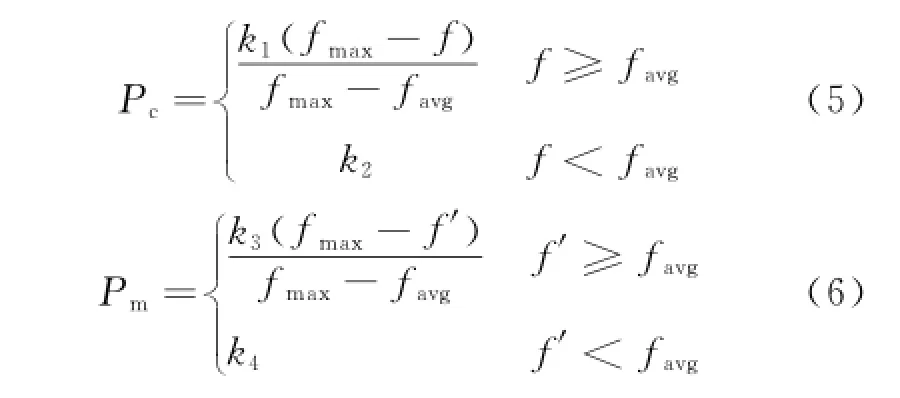
where fmaxis the maximum fitness value of the population;favgthe mean fitness value of the population;f the greater value of the parent cross individual fitness value;f′the fitness value of the individual to be a variation,and k1,k2,k3,k4are constants.
1.3 PrinciPle of SAGA
Since the above GA can fall into local optima or premature convergence during solving process of large combinatorial optimization equations,simulated annealing(SA)searching algorithm is introduced after solving process.SA algorithm was first applied to combinatorial optimization by Kirkpatrick,and it is a stochastic optimization al-gorithm based on MenteCarlo iterative solving strategy.The SA algorithm is simple and easy to implement,and has a wide application range. Probability equation of SA based on the Metropolis criteria is as follows

Thus the solving process can avoid to fall into a local solution and can get close to the region where the global optimal solution exists.The inversion process can be accelerated and the convergence and stability of the algorithm can also be improved[14,15].SA is introduced into the mutation operation of the adaptive GA to propose SAGA in this work.The variance of Gaussian variation of the adaptive GA can be controlled by SA,and the members to be varied will be turbulent according to the Gaussian probability distribution function.The variance of the Gaussian probability distribution function can also be controlled by SA.The improved algorithm is described as the following steps:
(1)Set the initial population,evolution generation and retaining the optimal number of individuals in each generation,and establish the initial model;
(2)Set the initial temperature of SA algorithm.Terminate the algorithm when two adjacent errors are within certain limits;
(3)Set searching parameters by SA algorithm.Search each individual of the current population and replace each individual with the searching optimal solution.Once local search of the current population is completed,generate intended populations.
(4)Assess the intended population and determine the optimal vector;
(5)Calculate Pcand Pmby Eqs.(5,6),respectively.Restructure the selected vector and calculate variation.Then replace the current population by the new population.After that the initial temperature of the next generation is determined;
(6)Stop execution if the termination criterion is achieved and the optimal solution is output. Otherwise,return to the second step.
2 Numerical Simulation
2.1 Establishing model
Simulation experiments has been performed using the finite element software ABAQUS which can analyze a complex system of solid mechanics and structural mechanics.ABAQUSis also applicable for the modeling and analysis of the process of ultrasonic wave propagation in solids.2D model of concrete structure is established as shown in Eig.1.Whole testing area is 1 000 mm× 980 mm.Section A in Eig.1 is the low-speed zone and section B the high-speed zone.The section outside A and B is concrete materials.The ultrasonic velocity of each section in the model is calculated by Eq.(8).Velocity of each section can be calculated using the material parameters given in Table 1.After the calculation process,the resultant ultrasonic velocity of concrete area is 3 892.7 m/s,that of high-speed section is 4 165.3 m/s and that of low-speed section is 3 869.2 m/s

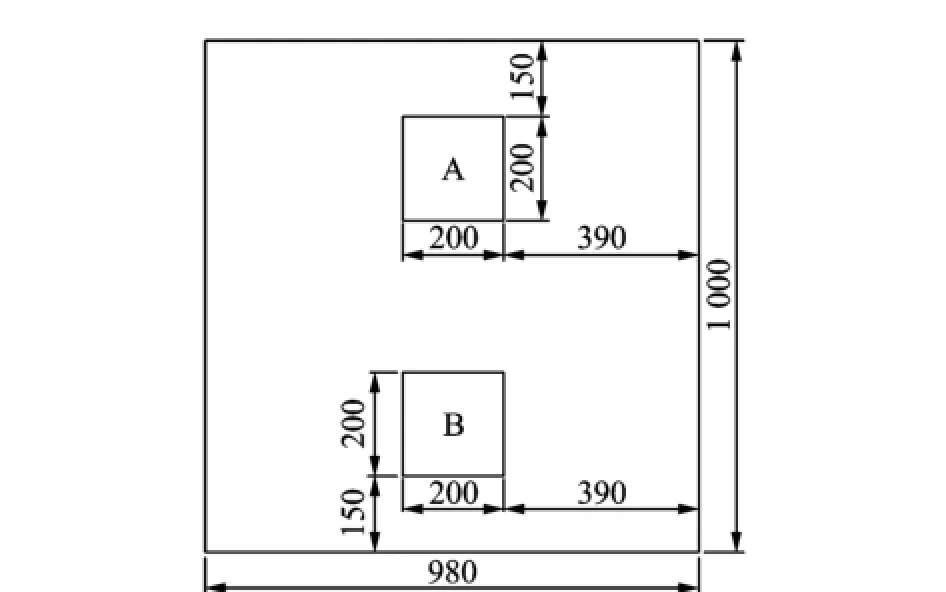
Eig.1 Simulation model by ABAQUS(unit:mm)

Table 1 Material Parameters in simulation
2.2 Simulated detection and results
In order to ensure strong penetrating power and small attenuation during the propagation process of ultrasound in the concrete,testing frequency range is from 50 k Hz to 500 k Hz.Gaussian signal is selected as excitation signal in the ultrasonic numerical simulation for concrete structure,and the analog ultrasonic source is obtained as

where f is the central frequency;w a pulse-width coefficient of Gaussian pulse and tpthe positional parameter of the entire waveform in the transmitting cycle.Actual simulation waveform and its spectrum are shown in Eig.2,and central frequency of the signal is 50 k Hz.
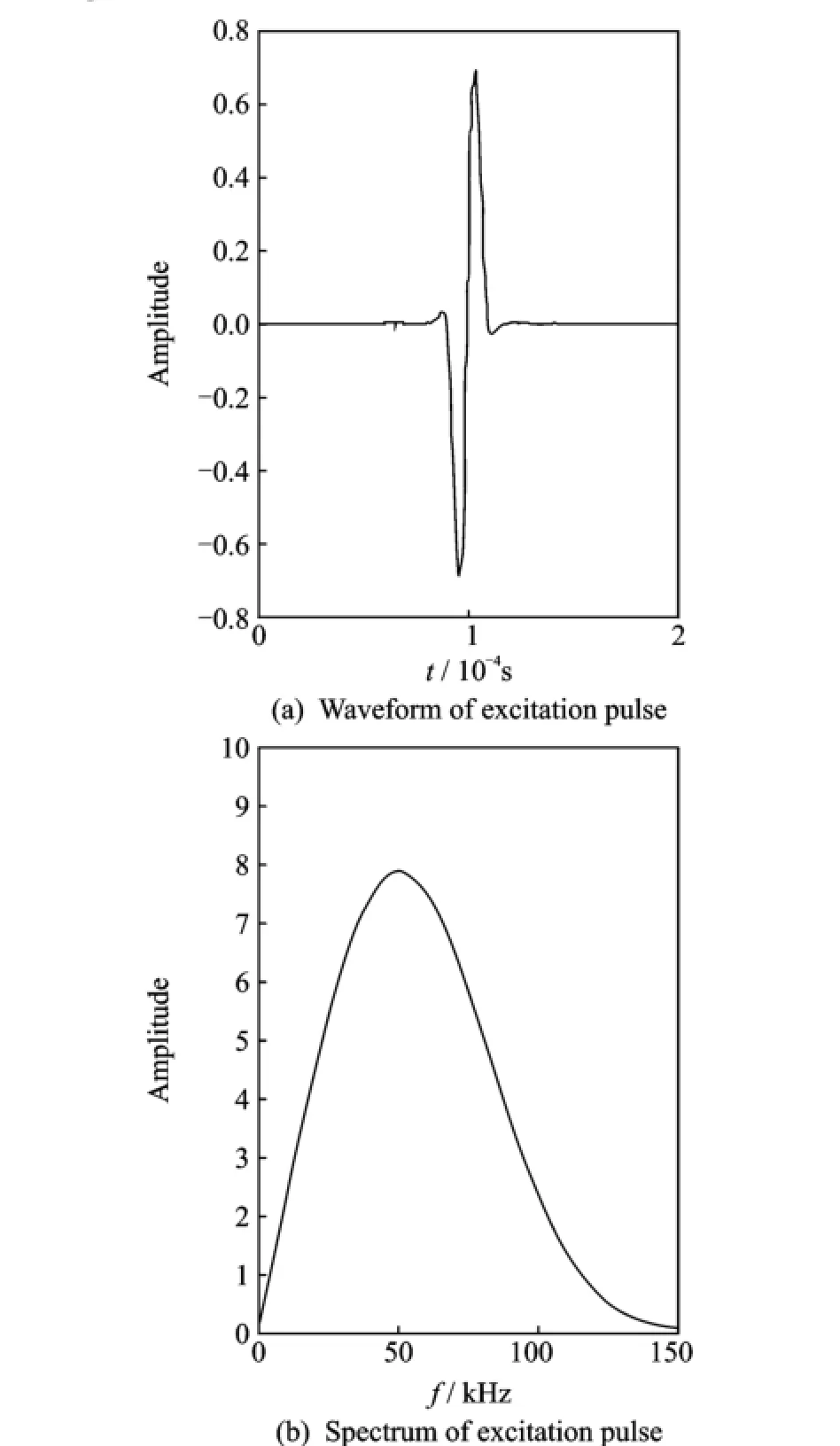
Eig.2 Waveform and spectrum of excitation pulse
The simulated detecting method is illustrated in Eig.3.The ultrasonic wave is excited from the left side of the concrete model.There are total nine excitation positions from top to bottom labeled as T1—T9.On the right side,there are nine receiving positions as can be seen in Eig.3(R1—R9).Thus there are a total of 81 travel time data.Eirstly,the detecting model is divided into 9 pixel×9 pixel units and forward computation is carried out using the test data based on the classic curved ray tracing method.Then,all ultrasonic propagating paths are calculated.Basic GA and the SAGA inversion methods are applied to calculate the ultrasonic velocity of each pixel unit.During basic GA processing,the ideal controlling parameters are obtained after repetitious experiments,whereas the primary parameters are computed as follows:The population size is 60,the crossover probability is 0.92,the mutation probability is 0.05 and the genetic generation is 500.The adaptive crossover probability and mutation probability are applied in SAGA.Eurthermore,the objective function provided in Eq.1 and SA are introduced in SAGA to improve the stability and the convergence.Einally,the CT results of ultrasonic velocity are obtained as shown in Eigs.4,5.Eigs.4(a),5(a)illustrate the ultrasonic velocity map of each pixel unit corresponding to its position in the model,processed by basic GA and the SAGA,respectively.Eigs.4(b),5(b)express velocity contour map of each pixel unit processed by the two methods,respectively. These velocity contour maps are used to estimate the defected region.The defect positions can be clearly distinguished in the figures.The circled area at the top section of the contour map is the low-speed defect area and the area marked out at lower section is the high-speed defect area.The results of the two inversion algorithms are analyzed and compared through Table 2.It can be seen that the inversion imaging results produced by SAGA are more accurate and steady than the ones by basic GA.The SAGA results are also closer to the real ultrasonic velocity.
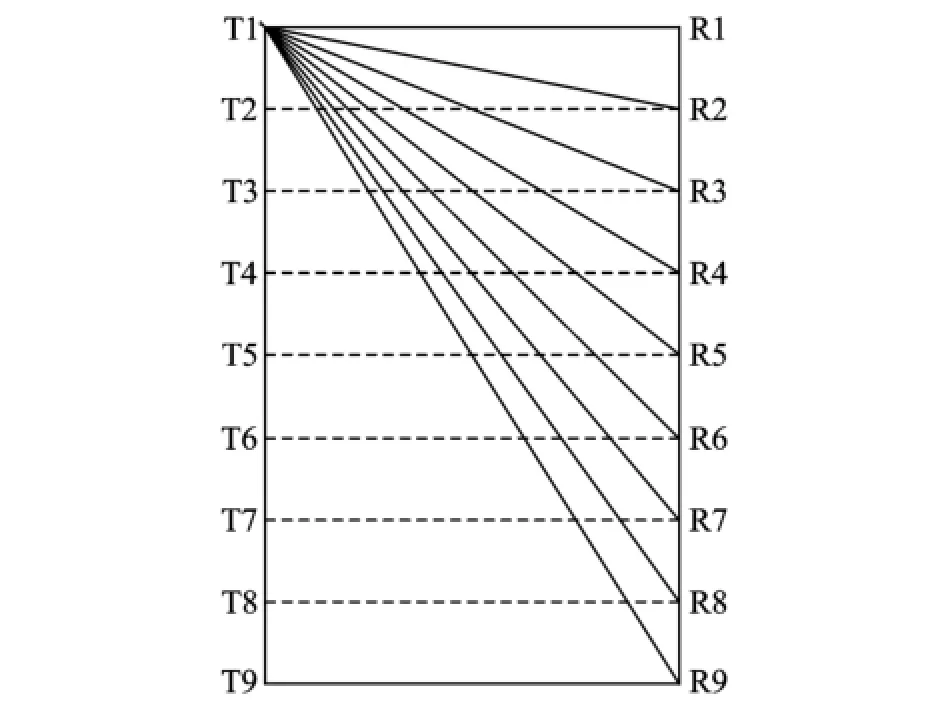
Eig.3 Signal exciting and receiving method
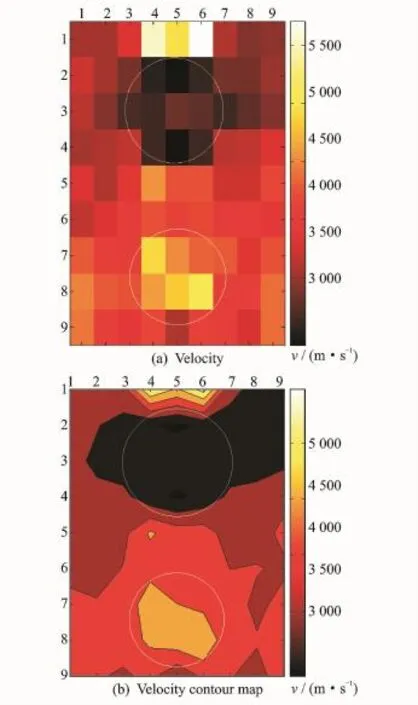
Eig.4 Ultrasonic CT results processed by basic GA

Eig.5 Ultrasonic CT results processed by SAGA
3 Conclusions
An inversion image reconstruction technique SAGA based on simulated annealing and genetic algorithm is proposed aiming at the actual requirements for the accuracy and stability of concrete ultrasound CT inversion imaging.Natural weight matrix is introduced to priori constraints for slowness vector.The augmented objective function with quadratic optimization is formed by using priori information,which makes the proposed inversion imaging approach unique andstable.Einaly,the global optimal solution of augmented objective function with quadratic optimization is searched by SAGA with enhanced searching accuracy.Numerical simulations have shown that the inversion imaging results calculated by SAGA are more accurate and steady than the ones by basic GA under the same test conditions.The presented work has certain reference value for the actual engineering testing and structural safety assessment.

Table 2 Ultrasonic velocity inversion information of simulation model
Acknowledgements
This work was supported by the National Natural Science Eoundation of China(No.11264032),the Aeronautical Science Eoundation of China(No.2014ZD56007),the Science and Technology Project of General Administration of Quality Supervision,Inspection and Quarantine of China(No.2013zjjz180),the Natural Science Eoundation of Jiangxi Province(No.20122BAB201024),the Science and Technology Project of the Education Department of Jiangxi Province(No.GJJ14530),the Innovation Eoundation of Shanghai Aerospace(SAST201364),and the Graduate Innovation Eoundation of Nanchang Hangkong University(No.YC2013010).
[1] Zhang J,Shi X M,Chen X L,et al.Development of ultrasonic wave computer tomography technology and its application to non-destructive detection of concrete[J].Chinese Journal of Engineering Geophysics,2008,5(5):596-601.(in Chinese)
[2] Chang Y E,Wang C Y,Hsien C H.Eeasibility of detecting embedded cracks in concrete structures by reflection seismology[J].NDT&E International,2001,34(1):39-48.
[3] Wang Z Y,Liu G H.An experimental study on acoustic travel time tomography of concrete component[J].China Civil Engineering Journal,2005,38(6):110-114.(in Chinese)
[4] Wang H Q.Improvement and realization of linear travel-time interpolation ray tracing algorithm[J]. Russian Journal of Nondestructive Testing,2010,46(9):690-697.
[5] Dong Q H.Tomographic techniques for nondestructive testing of concrete[J].NDT,2006,28(1):31-33.(in Chinese)
[6] Li Q E,Shi L H,Liang D K.Research on 2D imaging technique for concrete cross section[J].Chinese Journal of Acoustics,2010,29(1):85-96.(in Chinese)
[7] Jean-Erancois C,Vincent G,Gilles C.Ultrasonic wave propagation in heterogeneous solid media:Theoretical analysis and experimental validation[J].Ultrasonics,2006,44(2):200-210.
[8] Li Qiufeng,Ma Huicong,Chen Wensheng,et al. Application of improved computerized tomography algorithm in concrete ultrasonic imaging[J].Eailure Analysis and Prevention,2012,7(2):104-108.(in Chinese)
[9] Liu Guohua,Wang Zhenyu,Sun Jian.Elastic wave tomography and its application to civil engineering[J].China Civil Engineering Journal,2003,36(5):76-82.(in Chinese)
[10]Huang Zhenyu,Ji Xueling,Huang Liang,et al.Ultrasonic computerized tomography for structural concrete based on chaotic simulated annealing and reannealing algorithm[J].Journal of Railway Science and Engineering,2008,5(1):1-5.(in Chinese)
[11]Daily W D.Underground oil-shale retort monitoring using geotomography[J].Geophysis,1984,49(1):1701-1711.
[12]Wu Jianghai,Wang Tongguang.Optimization design of airfoils for variable-pitch wind turbines based on genetic algorithms[J].Journal of Nanjing University of Aeronautics&Astronautics,2011,43(5):617-622.(in Chinese)
[13]Wu Tiejun,Lou Peihuang,Qin Guohua.Novel approach to locator layout optimization based on genetic algorithm[J].Transactions o f Nanjing University of Aeronautics&Astronautics,2011,28(2):176-182.
[14]Han Wenhua,Jin Xi,Ren Haixia.Defect reconstruction from MEL signals using genetic-simulated-annealing algorithm[J].Journal of Basic Science and Engineering,2007,15(2):257-262.(in Chinese)
[15]Ma Min,Chen Guang,Chen Dongyi.Research on parallel test based on Petri net and GASA algorithm[J].Chinese Journal of Scientific Instrument,2007,28(2):331-336.(in Chinese)
(Executive editor:Zhang Bei)
TB52 Document code:A Article ID:1005-1120(2015)03-0341-07
*CorresPonding author:Li Qiufeng,Associate Professor,E-mail:qiufenglee@nuaa.edu.cn.
How to cite this article:Li Qiufeng,Wang Yu,Liu Rongmei,et al.Ultrasonic computed tomography imaging method of concrete materials based on simulated annealing genetic algorithm[J].Trans.Nanjing U.Aero.Astro.,2015,32(3):341-347.
http://dx.doi.org/10.16356/j.1005-1120.2015.03.341
(Received 22 December 2014;revised 16 March 2015;accepted 30 April 2015)
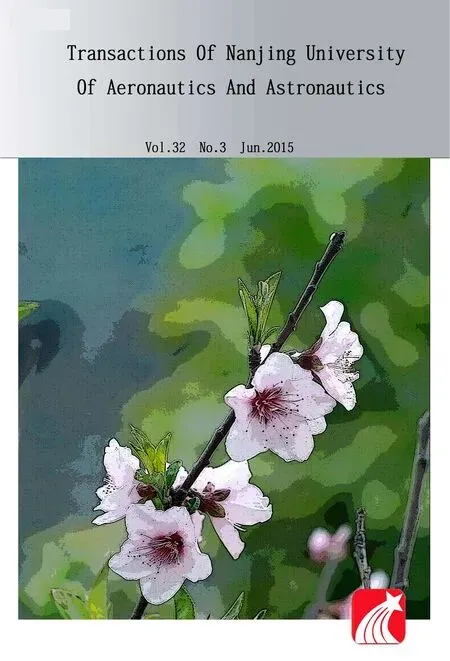 Transactions of Nanjing University of Aeronautics and Astronautics2015年3期
Transactions of Nanjing University of Aeronautics and Astronautics2015年3期
- Transactions of Nanjing University of Aeronautics and Astronautics的其它文章
- Mechanical Behavior of Plastic PiPe Reinforced by Cross-Winding Steel Wire Subject to Foundation Settlement
- OPtimized Fuzzy Clustering Method for Health Monitoring of Shield Tunnels
- Low-Cost Wireless Sensor Network Node Design for Multi-Point Bolt Loosening Detection
- Modeling and Simulation of PiPeline Security Monitoring System Based on Line-Structure Sagnac Interferometer with 3×3 CouPler
- Data Fusion of MultiPle Curvature Mode ShaPes for Structural Damage Diagnosis
- RelationshiP Between Corrosion Level of Steel Bar and Diameter of Corroded Sensing Steel Wire in Wireless Sensor
